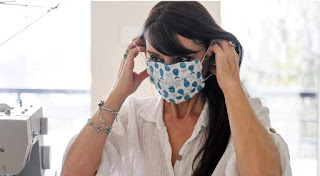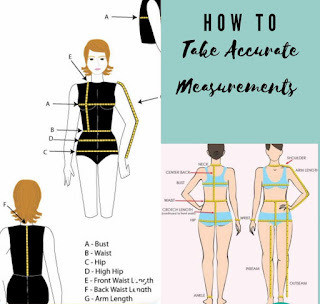FASHION TABLE WITH STEPHANIE: CHOOSING THE BEST MATERIAL TO MAKE A HOMEMADE FACE MASK
CHOOSING THE BEST MATERIAL TO MAKE A HOMEMADE FACE MASK.
A shortage of commercial masks means that improvising face coverings at home is the best way to protect ourselves and ensure a supply of masks for healthcare providers.
Cdc says and I quote "The cloth face coverings recommended are not surgical masks or N-95 respirators. Those are critical supplies that must continue to be reserved for healthcare workers and other medical first responders, as recommended by current CDC guidance".
Cotton fabric is the fabric of choice for cloth face coverings, because it can be easily laundered and doesn't change shape after laundry.
You can just cut the fabric from a cotton shirt at home and make a cloth face covering for yourself.
You can also make a cloth face covering from a bandana
According to Dr. Benjamin LaBrot, founder and CEO of Floating Doctors and a clinical professor of medical education at the Keck School of Medicine of University of Southern California, a surgical mask (that’s not an N95) only filters out about 60 to 65 percent of particles, which is normal for this type of mask.
He explains that by using doubled up 600-thread count pillowcases or flannel pajamas, you could make a mask that provides up to 60 percent filtration.
He also gave a test for choosing the right fabric for your household face covering, it's called "The LIGHT TEST"
“Hold it up to the light. If you can see light through the fabric, that’s probably not as good as something that you can’t see light through,” he said. “So, this is one where your intuitive approach is going to be effective. The thicker it is, the denser it is, the more likely it’s going to filter better.” Quilter’s cotton, which has a particularly high thread count, actually provides up to about 80 percent filtration of small particles, and actually performs better than a regular surgical mask,” he said.
But LaBrot warns that as you start using thicker stuff, you’ll run up against two issues.
First, it eventually gets hard to breathe. Second, some things, like household air or furnace filters, could be made of things like fiberglass and other substances that aren’t necessarily safe to breathe.
“So if you’re going to be using anything that’s not cotton, I’d definitely want to be careful of what materials you’re using,” LaBrot cautioned.
Summary of the whole Mágáná is that,
1. Cotton clothing can be used to make masks that filter about as well as normal surgical masks.
2. The thicker the material is, the better it works.
3. Quilter’s cotton could outperform normal masks.
4. Doubled up pillowcase and flannel pajamas fabric can give 60% protection.
Then let me add my own, if you are using ankara please add interface, it isn't as good as cotton, but interface makes it less porous. (This is just for those that feel they must use ankara ooo, cdc didn't sign off on using Ankara)
Check previous posts on fashion desk for how to make these homemade masks
For corroboration, check the cdc article here:
Link to cdc article https://www.cdc.gov/coronavirus/2019-ncov/prevent-getting-sick/diy-cloth-face-coverings.html
Stay safe, protect yourselves, practice social distancing and remember fam THIS TOO SHALL PASS.
Ask any questions or relay any message in the comment section or send me a dm. I'm waiting for your feedback guys.
Welcome back to "FASHION TABLE"
Always remember fam the goal is to thrive and not just survive.
Love, light and peace always from the side fam
Post by: Osaruyi Stephanie Aiseosa
IG: @stephanieonette_
Facebook: Stephanie Aiseosa Stephanie
Twitter: @Oaiseosa
A shortage of commercial masks means that improvising face coverings at home is the best way to protect ourselves and ensure a supply of masks for healthcare providers.
Cdc says and I quote "The cloth face coverings recommended are not surgical masks or N-95 respirators. Those are critical supplies that must continue to be reserved for healthcare workers and other medical first responders, as recommended by current CDC guidance".
Cotton fabric is the fabric of choice for cloth face coverings, because it can be easily laundered and doesn't change shape after laundry.
You can just cut the fabric from a cotton shirt at home and make a cloth face covering for yourself.
You can also make a cloth face covering from a bandana
According to Dr. Benjamin LaBrot, founder and CEO of Floating Doctors and a clinical professor of medical education at the Keck School of Medicine of University of Southern California, a surgical mask (that’s not an N95) only filters out about 60 to 65 percent of particles, which is normal for this type of mask.
He explains that by using doubled up 600-thread count pillowcases or flannel pajamas, you could make a mask that provides up to 60 percent filtration.
He also gave a test for choosing the right fabric for your household face covering, it's called "The LIGHT TEST"
“Hold it up to the light. If you can see light through the fabric, that’s probably not as good as something that you can’t see light through,” he said. “So, this is one where your intuitive approach is going to be effective. The thicker it is, the denser it is, the more likely it’s going to filter better.” Quilter’s cotton, which has a particularly high thread count, actually provides up to about 80 percent filtration of small particles, and actually performs better than a regular surgical mask,” he said.
But LaBrot warns that as you start using thicker stuff, you’ll run up against two issues.
First, it eventually gets hard to breathe. Second, some things, like household air or furnace filters, could be made of things like fiberglass and other substances that aren’t necessarily safe to breathe.
“So if you’re going to be using anything that’s not cotton, I’d definitely want to be careful of what materials you’re using,” LaBrot cautioned.
Summary of the whole Mágáná is that,
1. Cotton clothing can be used to make masks that filter about as well as normal surgical masks.
2. The thicker the material is, the better it works.
3. Quilter’s cotton could outperform normal masks.
4. Doubled up pillowcase and flannel pajamas fabric can give 60% protection.
Then let me add my own, if you are using ankara please add interface, it isn't as good as cotton, but interface makes it less porous. (This is just for those that feel they must use ankara ooo, cdc didn't sign off on using Ankara)
Check previous posts on fashion desk for how to make these homemade masks
For corroboration, check the cdc article here:
Link to cdc article https://www.cdc.gov/coronavirus/2019-ncov/prevent-getting-sick/diy-cloth-face-coverings.html
Stay safe, protect yourselves, practice social distancing and remember fam THIS TOO SHALL PASS.
Ask any questions or relay any message in the comment section or send me a dm. I'm waiting for your feedback guys.
Welcome back to "FASHION TABLE"
Always remember fam the goal is to thrive and not just survive.
Love, light and peace always from the side fam
Post by: Osaruyi Stephanie Aiseosa
IG: @stephanieonette_
Facebook: Stephanie Aiseosa Stephanie
Twitter: @Oaiseosa




Thank you for this
ReplyDeleteYou are welcome
DeleteI'm here for you 😁 😁
Delete